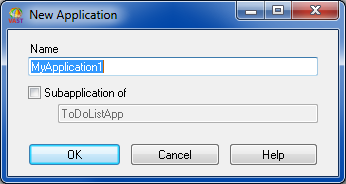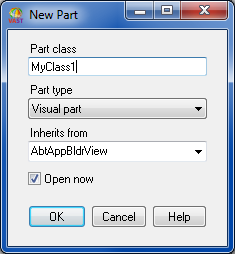Organizer
The Organizer is the starting point for visual programming. This is where you create your application and its parts.
The Organizer automatically opens when you start your development image.

Applications constructed from parts are listed in the left pane of the organizer. The parts belonging to a selected application are listed in the right pane.
There are many things which you can do with the organizer. In this book, the main thing is creating parts within an application while constructing the examples.
Adding part classes to your application
The Organizer provides several ways to create an application or a part.
1. The Quick Start Dialog allows you to create a visual part and an application.

2. The New... item in the Applications pulldown menu allows you to create an application.

3. The New... item in the Parts pulldown menu allows you to create a part in an existing application.

4. The New Part ( ) tool in the tool bar allows you to create a part in an existing application. It is an alternative to the pulldown menu.
) tool in the tool bar allows you to create a part in an existing application. It is an alternative to the pulldown menu.
You can add the following kinds of classes to your application. Using the New Part dialog allows you to choose the kind of class you are creating.
Visual parts
Visual parts are all the windows and other user interface elements of your application.
Nonvisual parts
Nonvisual parts are the parts that do not have a visual representation at runtime.
Smalltalk classes
Smalltalk classes specify the data and behavior of objects. They are not actually VA Smalltalk parts. You create Smalltalk classes to implement special logic, such as logic for your own data type converters.
If you have the Database and the Reports features loaded, you can also add the following kinds of classes:
Database access sets
Database access sets are the classes that store database query and stored procedure definitions.
Report parts
Report parts enable you to lay out reports such as accounting forms.
Which kind of class you choose will give your new part certain behaviors automatically. For instance, if you choose a visual part, your new part will understand how to display itself.
Last modified date: 03/26/2020